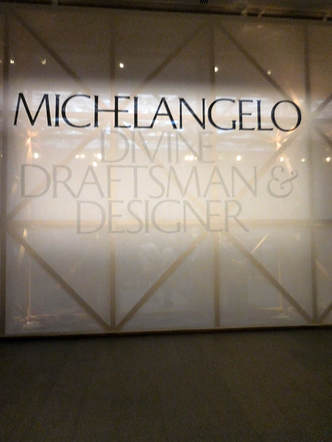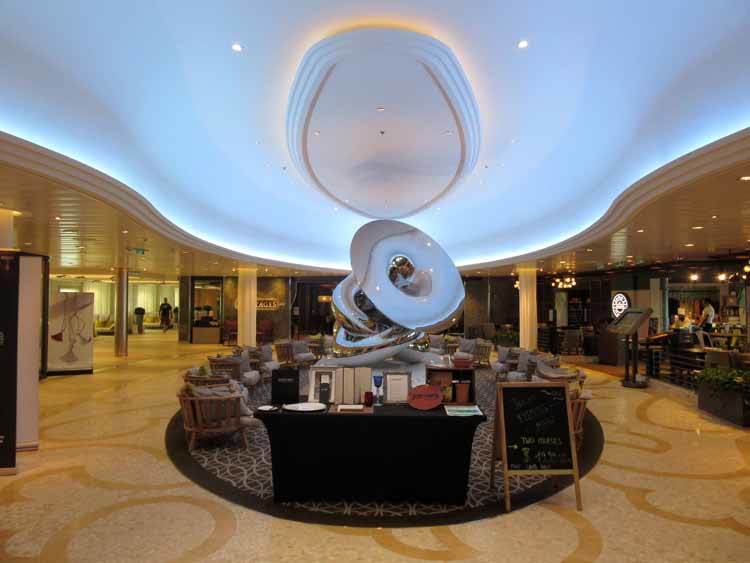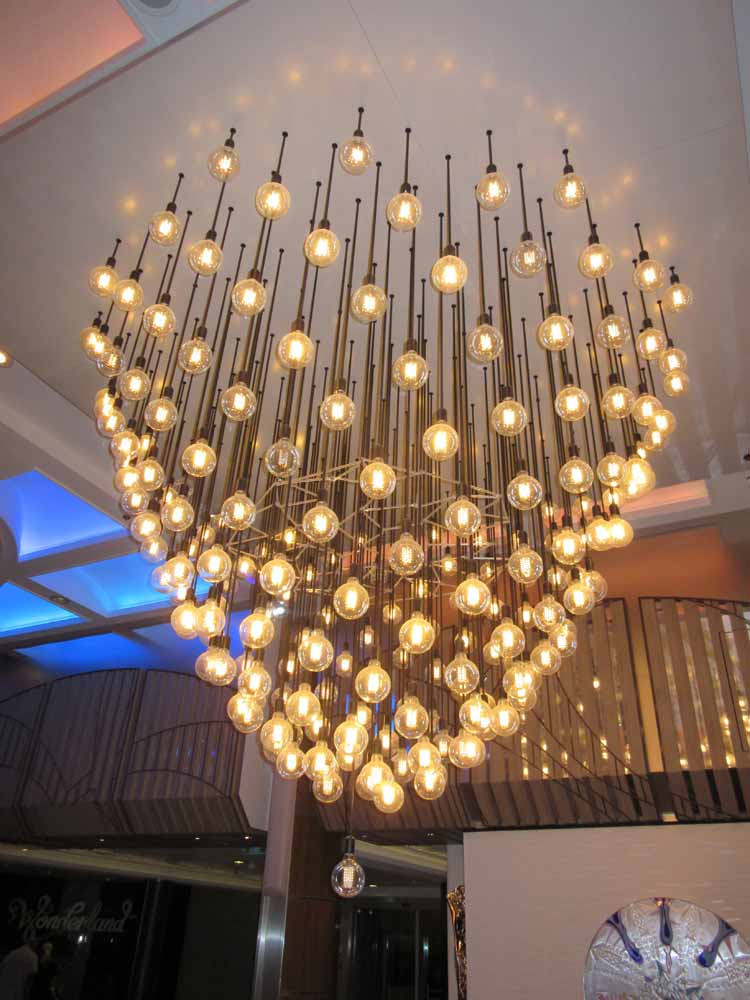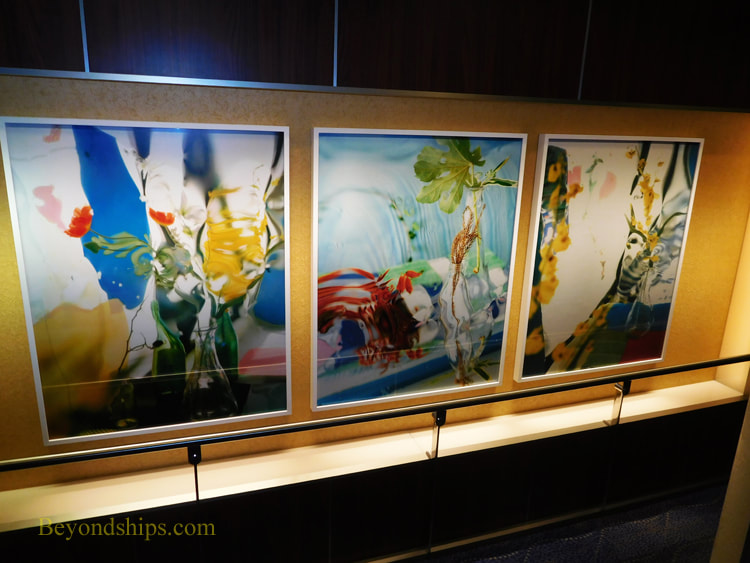 Royal Caribbean's Anthem of the Seas has a sophisticated contemporary décor. In fact, it is often said that the ship's decor looks more like a ship from Royal's premium affiliate Celebrity Cruises than the Las Vegas style décor of some of Royal's earlier ships. Accordingly, the art collection on Anthem is less aimed at eliciting a “wow” and more aimed at contributing to the ship's upmarket atmosphere. Anthem's art collection was assembled in partnership with International Corporate Art. It includes some 3,000 works of art. Almost all are contemporary works. The theme of the collection is “What Makes Life Worth Living.” According to the booklet about the collection, this theme encompasses “people, leisure, fashion, art &literature, food, adventure, entertainment & nature.” This scope is perhaps too broad as it is difficult to discern the theme just by walking around the ship and viewing the various works. However, knowing the theme is not vital to enjoying the art. Several large installations are included in the collection. At the center of ship's public areas is a grand chandelier created by Rafael Lorenzo Hemmer called “Pulse Signal.” It consists of some 200 light bulbs suspended from cords and arranged into a pleasing contemporary shape. The lights blink on and off in various arrangements thus changing the shape of the piece and the atmosphere of the area. It is a visually interesting piece. Guests can control the blinking of the lights by putting their hands on a pad that is located beneath the chandelier. The blinking is then synchronized with the guest's pulse. This does allow for viewer involvement with the art but I find it somewhat gimmicky and unnecessary. Just aft of the chandelier, ascending up the atrium is the prettiest piece in the collection, Ran Hwang's “Healing Garden.” Dark tree branches with bright blossoms are set against a gold background. The work recalls traditional East Asian cherry tree paintings. However, the artist has included non-traditional materials such as crystals, buttons and pins, which give the work a glamorous look. Going further aft, you come to a monumental sculpture by Richard Hudson. It is a swurling mass of highly polished metal. Although entitled “Eve”, it has become widely known as “The Tuba” because of its twisted horn-like shape. Despite this unfortunate nickname, it is an important piece consistent with the upscale shops, the cosmoploitan wine bar and the specialty restaurant that surround the plaza in which it is the centerpiece. You can find works that contribute to Anthem's sophisticated atmosphere throughout the public areas and on the staircases. However, there is also whimsy in the collection. For example, in each of the elevators there is a giant image of an animal. Deming Harriman has manipualted these images so that the various animals are wearing items of human clothing. By adding these items, the artist gives the animals human personalities, making the images both amusing and a commentary on human foilbles. Atop the ship is a larger than life sculpture of a giraffe wearing a swimming costume and an inner tube. Known as “Gigi” this lovable character by Jean Francois Fourtou marks the ship's amusement park area. There is also art along the corridors leading to the passenger cabins. These include contemporary photos staged so as to look like advertisements or scenes from 1950s America. There are also posters with inspirational slogans like the ones that the youth culture used to decorate college dormitories in the 1960s. Overall, the Anthem collection is successful. The theme is perhaps too broad to present a coherent message. However, the pieces are visually pleasing and often thought provoking, Also together, they serve to support the overall atmosphere of the ship. Above: Richard Hudson's Eve provides a centerpiece for one of the ship's plazas.
Below left: Ran Hwang's “Healing Garden” in the ship's atrium. Below right: "Pulse Signal" by Rafael Lorenzo Hemmer is in the center of Atrium's public area.  “David Hockney” is a retrospective exhibit of the works of David Hockney. It has previously been at the Tate Britain in London and the Pompidou Center in Paris. We saw it at New York's Metropolitan Museum of Art. Britain's best known living artist, David Hockney was born in Yorkshire in England in 1937. After studying art in Bradford, he moved to London in 1959 to study at the Royal College of Art where he achieved a reputation as a superstar. A trip to Southern California in 1964 resulted in a lifelong fascination with California where he has lived on and off for 50 years. Now 80, Hockney continues to produce art each day. The exhibition presents 60 canvases, 21 portrait drawings and a number of other examples of his work arranged in eight galleries. They are grouped roughly in chronologist order. A retrospective exhibition allows the viewer to survey the artist's body of work and learn something about the artist that you cannot learn by just viewing an individual work. For example, although Hockney achieved success at an early age, he did not just stick with that winning formula. Rather, the exhibition shows a willingness to experiment with different ideas. But this does not mean that he abandoned everything when he moved from one idea to another. To illustrate, Hockney's early work was abstract. Abstraction was the style that the art establishment endorsed in the early 1960s and so it is not surprising that a young artist of that era would do that type of work. On the surface, Hockney would seem to have abandoned abstraction in favor of a more figurative style when he progressed to his California swimming pool works (probably his most famous works). But, his use of geometric shapes (i.e. rectangles) in those pictures recalls Modernist thinking. Still later, his landscapes have the flavor of artists such as Picasso and Matisse, not only in the choice of colors but in the use of shapes. We also see Hockney's predominant form of work move from abstraction to realistic genre scenes, to portraits to landscapes. With regard to portraits, the exhibit presents both examples of his famous double portraits and examples of portrait drawings. The double portraits are on a monumental scale and the figures seem to be isolated with invisible defensive walls separating them from each other. The portrait drawings are smaller and more revealing of the sitters' personalities. The walls are down. Yet another characteristic that comes through in the exhibit is Hockney's willingness to experiment with different media. He is best known as a painter, first using oils but then becoming one of the foremost users of acrylics. However, he has also experimented with watercolor, etchings, photography, photocopiers, fax machines and more recently digital art. In fact, the exhibit has three examples of works that he did on iPads.  “Michelangelo: Divine Draftsman and Designer” at the Metropolitan Museum of Art presents some 200 works by Michelangelo and his contemporaries. It includes 133 of Michelangelo's drawing as well as three of his marble sculptures gathered from 48 museums and private collections. It is a monumental exhibit. Although Michelangelo considered himself to be primarily a sculptor in marble, he was also a painter and an architect. In this exhibition, we see that the foundation of his art in all of these disciplines was drawing. But more than mere draftsmanship, his drawing reflected a quality of design. The exhibition uses the Italian word disego to capture this concept. Very few of the works in this exhibition were meant for public display. Rather, they were preparatory drawings made in order to work out ideas that would be used in paintings or sculptures. Others served to illustrate ideas for buildings. Because they were made further back in the creative process, they reveal something of how Michelangelo developed his ideas. To illustrate how some of the drawings led to finished works, the exhibit has a one quarter size reproduction of the ceiling of the Sistine Chapel displayed ion the ceiling of one of the galleries. Visitors can look up from Michelangelo's drawing and see how that idea was used in the final masterpiece. The exhibit also places the drawings in context. For example, the exhibit is open about Michelangelo's love of young men and explains that his “divine heads” were drawings that he did of those men and as presents for them. It also discusses his platonic relationship with the poet Vittoria Colonna and presents the drawings that he did when he came under her influence. It also looks at his relationship with other artists. To illustrate, Raphael began to achieve success in Rome at a time when Michelangelo was living in Florence. In order to compete with Raphael, Michelangelo fed ideas to the painter Sebastiano. Michelngelo's powerful marble bust of Brutus is presented along with a Roman statue that inspired Michelangelo and a bust of Julius Caesar made by a contemporary of Michelangelo. This allows us to see the debt that Michelangelo owed to the ancients as well as how his work broke with what was fashionable when Michelangelo created his Brutus. Michelangelo is one of the best known artists of all time. Yet, this exhibit sheds light on his creative process and career that may not have been generally appreciated before. This week, we take a look at the art collection on the cruise ship Celebrity Reflection. Celebrity Cruises has been collecting art and displaying art on its ships since its founding. Credit for beginning the Celebrity Art Collection in the 1990s is usually give to Christina Chandris, wife of John Chrandis then the owner of Celebrity Cruises. The line has since been purchased by Royal Caribbean Cruises Ltd. but the tradition of having an art collection aboard the ships continues. Responsibility for assembling the art collection on Celebrity Reflection, which entered service in 2012, was given to a firm called International Corporate Art. As when Ms. Chandris began the collection, the works on Celebrity Reflection are contemporary. They are primarily conceptual with much use of photographic images and non-traditional materials. There is almost no use of traditional techniques such as drawing or painting. The collection is prominently displayed. Indeed, there are several large installations that occupy considerable space. The works on the forward and aft stair towers are beautifully lit and dominate the landings. Clearly, the art collection was not an after thought. Since the name of the ship is Reflection, the theme of the collection is “the seductiveness of reflection.” The term “reflection” is meant both in the literal sense of surfaces that reflect light and in the metaphysical sense of thinking (reflecting) on a topic. If you look for this theme in the works, you can find it but it is not really vital to appreciating these works. Next to each work is a plaque discussing the work. These tend to be somewhat enthusiastic, using strings of adjectives and phrases which meld together to become rather meaningless. They obscure rather than clarify but that is often the case with the art establishment. Good art does not require verbose explanations. Each of Celebrity's Solstice class ships has a living tree suspended in the central atrium. On Reflection, this centerpiece was designed by Bert Rodriguez. The tree grows upward out of a shiny metallic basin. On the bottom of the basin is an aluminum tree pointing downwards. In other words, the aluminum tree is like a reelection of the living tree. However, unlike the living tree, the man-made tree is without leaves, only colorless electric lights adorn its branches. Another major installation is located by the specialty restaurants. On either side of the corridor are large photographic images from a forest. However, each of the trees has been perforated with reflective materials in each of the holes. Thus, you can glimpse your image moving through the forest as you pass by. It is visually impressive. The artist was Albano Afonso. Not far away is another installation, the Celestial Garden by Carlos Betancourt in collaboration with Alberto Latorre.. Colorful flowers contrast cover the walls, ceiling and floor, set against dark, nearly black backgrounds. Quite pretty. A shiny, abstract-shaped bench provides the reflective element. Of the works in the stairtowers, I found the photographic images by Miranda Lictenstein the most appealing. She manipulates the images so that they become essentially unrecognizable forming abstract designs. Her choice of pastel, natural colors in these images, however, makes them attractive. I was also impressed by the life-size silhouette at the top of this same tower, a photographic image by Yuki Onodera. The sparkling lights on the woman's dress are actually fragments of other photographic images. I did not find everything in the Celebrity Reflection collection appealing. However, I did find the collection thought provoking. I could not dismiss any of the works out of hand. Rather, I had to think about why I did not like a particular work. Causing viewers to think is a hallmark of a good collection. Above left: "Untitled #2", "Untitled #4" and Untitled #7" by Miranda Lichtenstein in the aft stair tower.
Above right: An installation by Albano Afonso. |
AuthorRich Wagner is a writer, photographer and artist. Archives
November 2018
Categories
All
|







 RSS Feed
RSS Feed